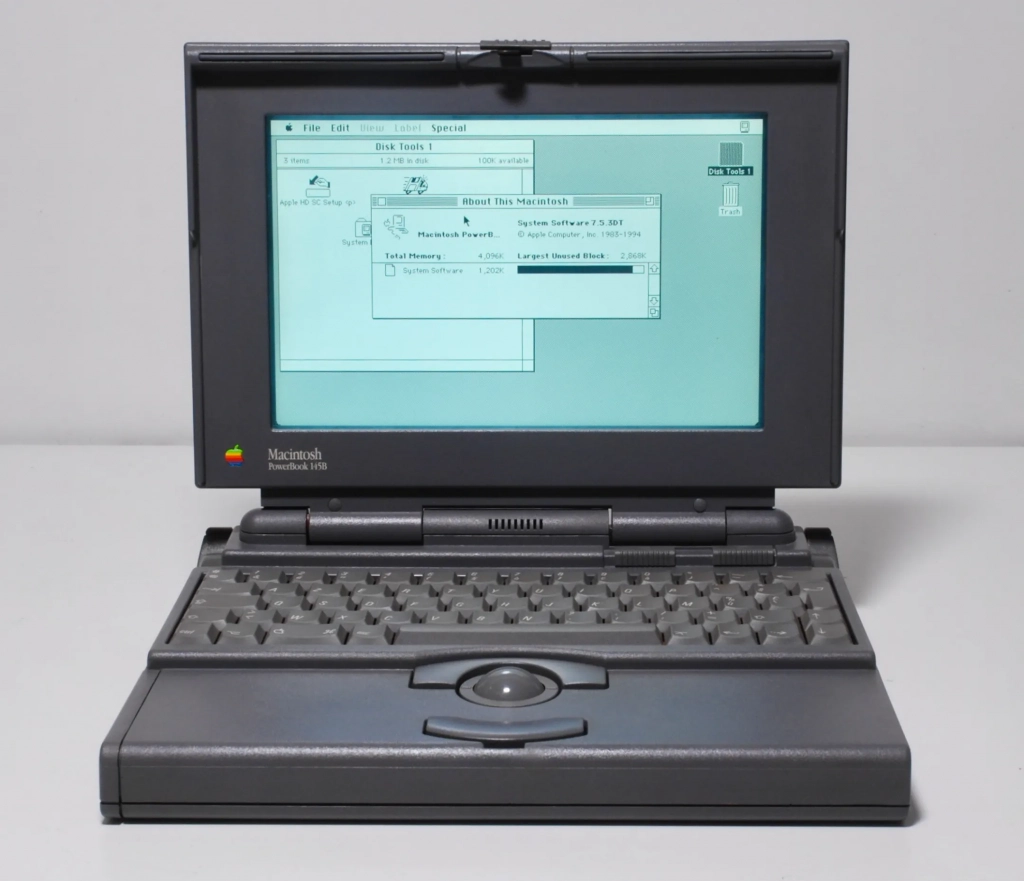In the fast-paced world of technology, products come and go, but some leave an indelible mark on the industry. One such device was the Apple Macintosh PowerBook 145B, a notebook computer that emerged in the early 90s.
Although it had a short lifespan, this portable machine captured the hearts of many Macintosh enthusiasts and played a significant role in shaping the trajectory of Apple’s future products. Today, as we commemorate its 31-year anniversary, let’s take a nostalgic journey back to the era when the PowerBook 145B reigned supreme.
On June 7, 1993, Apple unveiled the PowerBook 145B, a member of the esteemed Macintosh PowerBook series. Priced at $1,150, this compact notebook aimed to provide users with a reliable computing experience on the go.
Equipped with a 25 MHz Motorola 68030 processor, 4 MB of RAM, and a choice of either a 40 MB or 80 MB hard drive, it was a capable machine for its time. The 9.8″ monochrome LCD display and the standard 1.44 MB floppy drive completed the package, catering to the needs of users in an era dominated by monochrome displays and floppy disks.
Although the PowerBook 145B had a relatively short lifespan, lasting only a year before being discontinued on July 18, 1994, its impact was far from forgettable. Macintosh users in the early 90s relied on this machine for its stability and dependability. The 25 MHz 68030 processor, coupled with the ample onboard RAM, ensured smooth multitasking and efficient performance. Apple had successfully created a portable workhorse that could handle the demands of the era’s productivity tasks with ease.
The PowerBook 145B succeeded the PowerBook 145 and introduced a few noteworthy changes. Apple aimed to optimize production costs without compromising performance. One notable alteration was the increase in onboard RAM from 2 MB to 4 MB. While this may seem modest by today’s standards, it made a noticeable difference in enhancing the machine’s capabilities. The PowerBook 145B retained the features that made its predecessor popular while offering improved value to consumers.
While the PowerBook 145B may not have had a long run, it paved the way for future iterations in the PowerBook series. The 145B’s legacy was carried forward by its successor, the 33 MHz PowerBook 150, which arrived on the scene in mid-1994. Building on the success of its predecessors, the PowerBook 150 continued to refine the formula, offering enhanced performance and features that catered to the evolving needs of users.
31 years have passed since the Macintosh PowerBook 145B made its debut, and it remains a symbol of Apple’s commitment to innovation and excellence. Despite its relatively short existence, the PowerBook 145B proved to be a solid and reliable companion for many Macintosh enthusiasts of the early 90s.
While technological advancements have rendered it obsolete, its impact on the industry and the memories it created are far from forgotten. As we celebrate its anniversary, let us acknowledge the PowerBook 145B’s place in the annals of technological history and recognize its contributions to the world of portable computing.

Macintosh PowerBook 145B Details
| Introduced | June 7, 1993 |
| Discontinued | July 18, 1994 |
| Model Identifier | 54 |
| Model Number | M1592LL/A M4855LL/A |
| Original Price | $1,150 $2,150 $2,350 |
| Colors | Grey |
| Weight | 6.8 Ibs. 3.084 KG |
| Dimensions | 2.25” H x 11.25” W x 9.3” D 5.71 cm H x 28.57 cm W x 23.62 cm D |
PowerBook 145B Tech Specs
Processor
| Processor | Motorola 68030 |
| Processor Speed | 25 MHz |
| Architecture | 32-bit |
| Number of Cores | 1 |
| System Bus | 25 MHz |
| Cache | 0.5 KB L1 |
| Coprocessor | None |
Storage & Media
| Storage | 40 MB 80 MB |
| Media | 1.44 MB floppy |
Memory
| Built-in Memory | 4 MB |
| Maximum Memory | 8 MB |
| Memory Slots | 1 – PowerBook 1xx (70-pin connector) |
| Minimum Speed | 100 ns |
| ROM | Unknown |
| Interleaving Support | No |
Display
| Built-in Display | 9.8″ diagonal passive-matrix reflective LCD |
| Resolutions | 640 x 400 |
Graphics
| Graphics Card | None |
| Graphics Memory | None |
| Display Connection | None |
Expansion
| Expansion Slots | Internal 20-pin connector for the optional 2400-baud modem card |
| Hard Drive Interface | 40-pin SCSI |
| Bays | Unknown |
Connections
| Wi-Fi | None |
| Ethernet | None |
| Modem | None |
| Bluetooth | None |
| ADB | 1 |
| Serial | 2 |
| SCSI | HDI-30 |
| Floppy Port | None |
| Audio In | 1 – 3.5-mm analog input jack 1 – Built-in microphone |
| Audio Out | 1 – 3.5-mm analog output jack 1 – Built-in speaker |
| Infrared | None |
| Display | None |
Keyboard and trackpad
| Keyboard | Built-in 64-key (U.S.) or 64-key (ISO) 3.0-mm travel keyboard |
| Trackpad | Built-in 25-mm trackball pointing device |
Software
| Original OS | System Software 7.1 |
| Maximum OS | Mac OS 7.6.1 |
| Firmware | Macintosh ROM |
Power
| System Battery | 2.5-ampere-hour NiCad battery |
| Backup Battery | 3 V lithium |
| Maximum Continuous Power | 17 W |
| Line Voltage | Unknown |
| Power Adapter | Unknown |
